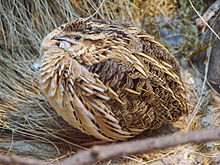- Coturnism
-
Coturnism is an illness featuring muscle tenderness and rhabdomyolysis[1] (muscle cell breakdown) after consuming quail (Coturnix coturnix,[2] from which the name derives). The condition was certainly known by the 4th century BC to ancient Greek and subsequently Roman naturalists, physicians and theologians. The Bible (Numbers 11:31-34) mentions an incident where the Israelites became ill after having consumed large amounts of quail.[3] Among the early writers describing quail poisoning or discusing the toxic attributes of quail are Aristotle (On Plants 820:6-7), Philo (Geoponics: 14: 24), Lucretius (On the Nature of Things: 4: 639-640), Philo (The Special Laws: 4: 120-131), Galen (De Temperamentis: 3:4) and Sextus Empiricus (Outlines of Pyrrhonism: 1: 57). Central to these ancient accounts is the thesis that quail became toxic to humans after consuming seeds from either hemlock (Conium maculatum) or henbane (Hyoscyamus niger)".[citation needed]
Migration routes and season may affect quail risk.[4] Quail are never poisonous outside the migration season nor are the vast majority poisonous while migrating.[citation needed] European Common Quail migrate along three different flyways each with different poisoning characteristics, at least in 20th century records. The western flyway across Algeria to France is associated with poisonings only on the spring migration and not on the autumn return. The eastern flyway, which funnels down the Nile Valley is the reverse. Poisonings were only reported in the Autumn migration before the quail had crossed the Mediterranean. The central flyway across Italy had no associated poisonings.[5]
From case histories it is known that the toxin is stable as 4 month old pickled quail have been poisonous. Humans vary in their susceptibility, only one in four people who consumed quail soup fell ill and the toxin is in the fat as potatoes fried in quail fat proved poisonous.[6]
Migrating quail used to be caught and eaten in prodigious numbers (150,000 quail exported from Capri in 1850) [7] but modern farming and droughts in the Sahel have led to a vast reduction in the size of the migrations. Conservation efforts and the availability of farmed quail have also reduced the consumption of these wild birds. Coturnism may well disappear before it is understood.
It has been suggested that Galeopsis ladanum seeds are not responsible.[8]
Coniine from hemlock consumed by quail has been suggested as the cause.[9] Hellebore has also been suggested as the source of the toxin.[10]
References
- ^ Korkmaz I, Kukul Güven FM, Eren SH, Dogan Z (October 2008). "Quail Consumption Can Be Harmful". J Emerg Med. doi:10.1016/j.jemermed.2008.03.045. PMID 18963719. http://linkinghub.elsevier.com/retrieve/pii/S0736-4679(08)00470-8.
- ^ Tsironi M, Andriopoulos P, Xamodraka E, et al. (August 2004). "The patient with rhabdomyolysis: have you considered quail poisoning?". CMAJ 171 (4): 325–6. doi:10.1503/cmaj.1031256. PMC 509041. PMID 15313988. http://www.cmaj.ca/cgi/pmidlookup?view=long&pmid=15313988.
- ^ Ouzounellis T (16 February 1970). "Some notes on quail poisoning". JAMA 211 (7): 1186–7. doi:10.1001/jama.1970.03170070056017. PMID 4904256.
- ^ Giannopoulos D, Voulioti S, Skarpelos A, Arvanitis A, Chalkiopoulou C (2006). "Quail poisoning in a child". Rural Remote Health 6 (2): 564. PMID 16700632. http://www.rrh.org.au/articles/subviewnew.asp?ArticleID=564.
- ^ Coturnism: Human Poisoning By European Migratory Quail Journal of Cultural Geography Volume 7, Issue 2, 1987, Pages 51 - 65 Authors: David C. Lewis; Elizabeth Metallinos-Katzaras; Louis E. Grivetti DOI: 10.1080/08873638709478507
- ^ Coturnism: Human Poisoning By European Migratory Quail Journal of Cultural Geography Volume 7, Issue 2, 1987, Pages 51 - 65 Authors: David C. Lewis; Elizabeth Metallinos-Katzaras; Louis E. Grivetti doi:10.1080/08873638709478507
- ^ Toschi A., 1959 La Quaglia, vita - caccia - allevamento Supplemento alle Ricerche di Zoologia Applicata alla Caccia, &c. Vol. 3, No. 1 Bologna.-Regia Universita Degli Studi.-Istituto Zoologico p110
- ^ Uriarte-Pueyo I, Goicoechea M, Gil AG, López de Cerain A, López de Munain A, Calvo MI (November 2009). "Negative evidence for stachydrine or Galeopsis ladanum L. seeds as the causal agents of coturnism after quail meat ingestion". J. Agric. Food Chem. 57 (22): 11055–9. doi:10.1021/jf902764n. PMID 19860419.
- ^ Clatworthy, Menna (2010-03-15). Nephrology: Clinical Cases Uncovered. John Wiley and Sons. pp. 145–. ISBN 9781405189903. http://books.google.com/books?id=55VOagYjaVkC&pg=PA145. Retrieved 10 August 2011.
- ^ Dobbs, Michael R. (2009-05-22). Clinical neurotoxicology: syndromes, substances, environments. Elsevier Health Sciences. pp. 166–. ISBN 9780323052603. http://books.google.com/books?id=Pmcy24y2HyMC&pg=PA166. Retrieved 10 August 2011.
Categories:- Toxic effect of noxious substances eaten as food
Wikimedia Foundation. 2010.

